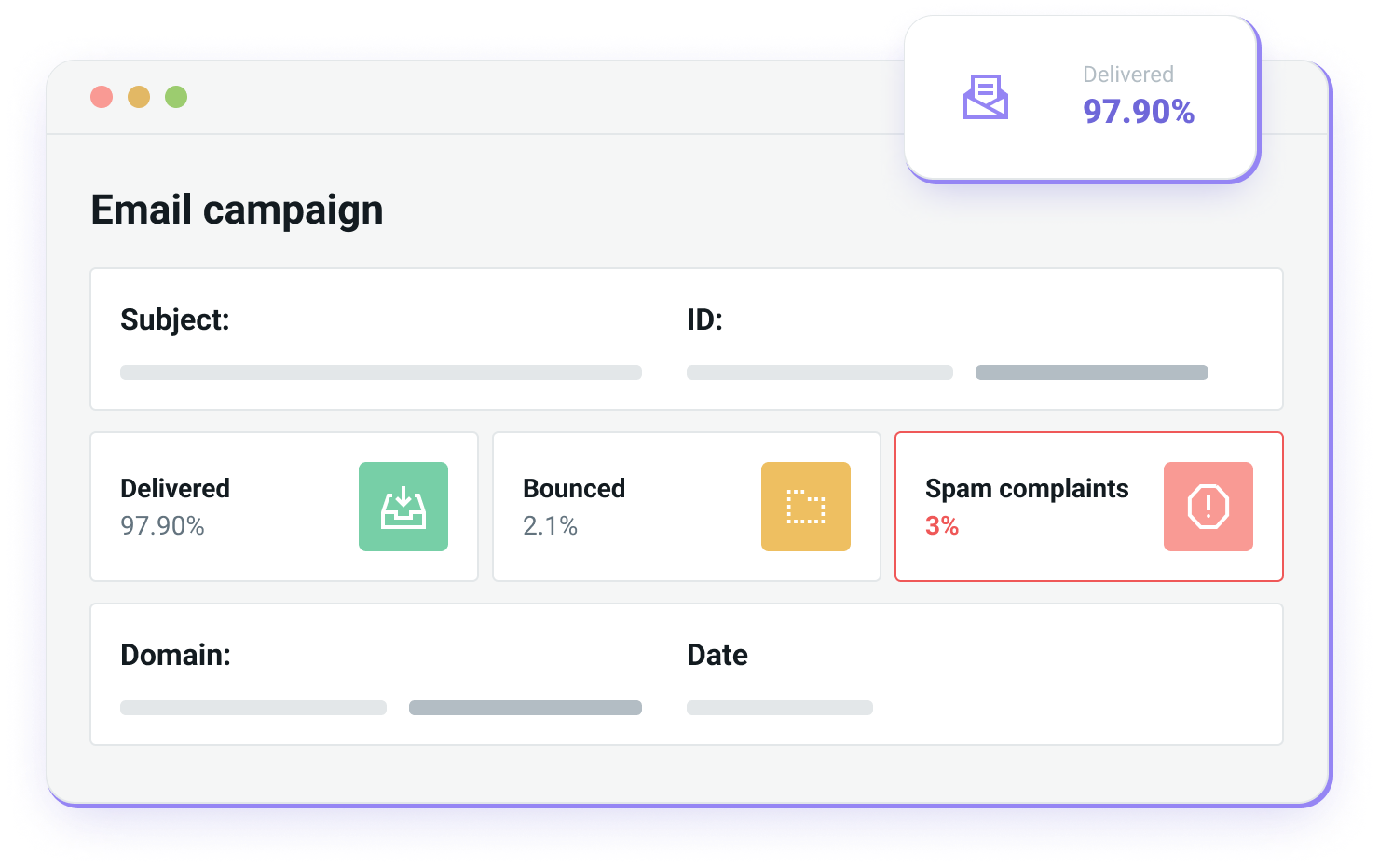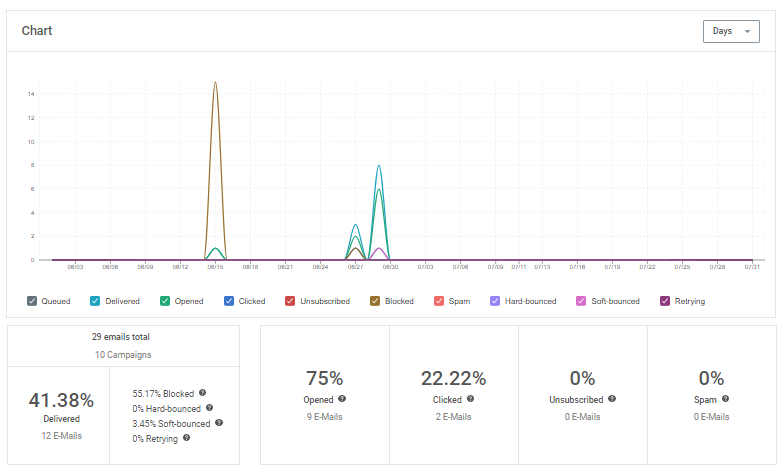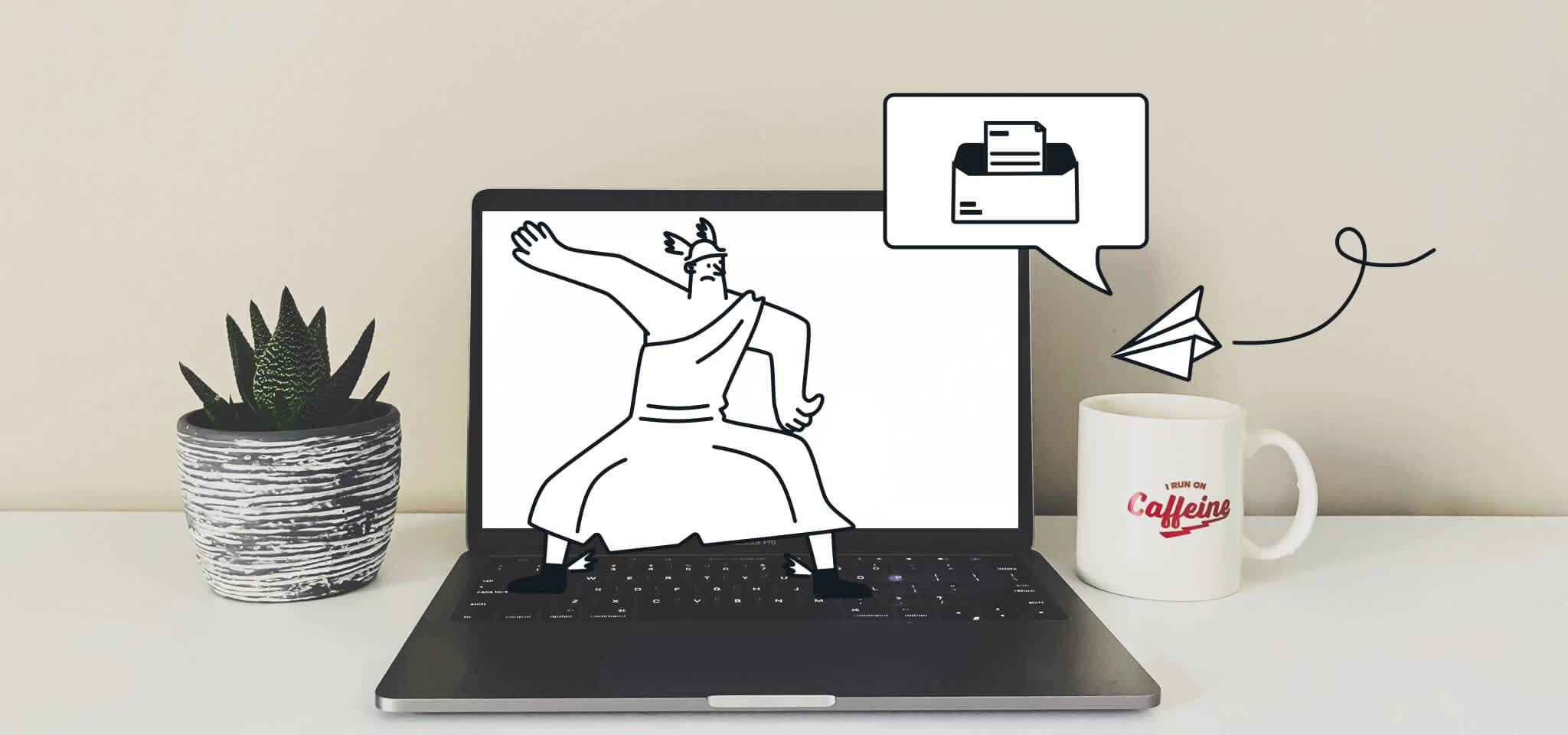Deliverability
How to avoid email spam filters
If you're wondering how to avoid email going to the spam folder this article is for you. Become an email deliverability expert now.

PUBLISHED ON
So, you're sick and tired of hearing about your beautiful emails landing in spam? We get it – there’s nothing we hate more than seeing great email go to waste.
If you’re responsible for your organization’s email campaigns, you’re probably constantly thinking about how to avoid spam filters, spam words, and always landing in the inbox – even more so now that Gmail and Yahoo have announced stricter spam thresholds for bulk senders starting 2024.
It can be a stressful and tedious job, but once you take a step back, you’ll see that stopping email from going to the junk folder doesn't need to be that complicated.
In this article, we’ll help you start off on the right foot and land your email to its intended recipient. We’ll first help you understand what email spam is, what tactics you can employ to avoid the spam folder, what words and phrases to avoid, and finally how to run spam filter tests.
Table of content
Spam filter definition
Spam trap definition
Soft bounce definition
Hard bounce definition
How to stop emails from going to the spam folder
Email content:
Monitor your email lists
Use email authentication with SPF, DKIM, and DMARC
Invoice
PayPal, Visa/MasterCard, or any bank name
Lottery, Free Gift, Prize
Urgent, Desperate, Please Help
Casino, Free Spins, Deposit Bonus
How do I run a spam test?
1. Management and monitoring of the reputation to avoid the spam folder
2. Access to authentication tools: SPF and DKIM
3. Optimization of the sending pace (i.e. throttling)
4. Optimization of the HTML structure of the email
5. Statistics, feedback loops, and relationship with ISPs
Table of content
01What is email spam and junk email?
02Email deliverability definitions
03How to get emails delivered to the inbox instead of the spam folder
04Advice on how to send bulk email without spamming
05How spam trigger words are setting off spam filters
06Spam checkers and spam filter testing: How to prevent email from going to spam
What is email spam and junk email?
Spam, or junk email, refers to unsolicited and often irrelevant email typically sent in bulk to a large, random number of recipients.
Of course, there’s a difference between spam and spam folders, which is the repository of all things that email clients, Internet Service Providers (ISPs), and recipients consider spam. Not everything in the spam folder is malicious, and in fact a lot of it isn’t. That’s why it’s important to adhere to best practices to avoid being marked as spam yourself.
Malicious content has been all but removed by Internet Service Providers (ISPs), who have strengthened their filters in the past few years. This is largely in part to the implementation of anti-spam laws (GDPR, CAN-SPAM Act, CASL, etc.,) designed to help protect recipients’ data.
It’s also easier than ever for consumers to mark emails as spam through ever-improving mail provider web UI. One-click buttons on clients like Gmail which will then store future email from this sender in the junk folder.

Gmail’s features allow users to easily unsubscribe from emails they no longer want to receive.
Email deliverability definitions
In our recently published State of Email Deliverability Report 2023, 36.2% of surveyed participants said that improving email deliverability was their highest priority goal. That’s because there’s no point spending time crafting great content if your messages are never seen.

But before we look a little closer at what that means, we should probably start out defining some of the subject’s key terms.
Spam filter definition
There are a lot of checks that happen when an email goes through the server. ISPs (such as Gmail, Yahoo, AOL) have put filters in place to protect spam or malicious email from landing in a recipients’ inbox.
One thing to keep in mind is that deliverability is different from delivery. The two sound very similar but shouldn’t be confused.
Deliverability is defined as a list of techniques, rules, and advice given to senders to ensure the highest percentage of their emails arrive to a recipient’s inbox, not the spam folder.
Spam trap definition
A spam trap is an email address that is not used for communication, and it should never receive emails; if it does receive email, then it is automatically considered to be spam and is a strong signal ISPs may use to degrade your sender reputation.
Soft bounce definition
A soft bounce is when an email is sent back to the sender, but only for temporary delivery issues. This can be because the user’s inbox is full, the server is down or the message is too big for the recipient’s inbox.
Hard bounce definition
A hard bounce is when an email is sent back to the sender because it couldn’t be delivered for permanent reasons. It could be that the email address was typed incorrectly, or a fake one was entered because the subscriber was more interested in receiving the perk or offer for signing up than receiving your email.
This is why it’s always helpful to set up double opt-in.
How to get emails delivered to the inbox instead of the spam folder
How to stop emails from going to the spam folder
You could create the greatest email marketing campaign the world has ever seen, but if it can’t make its way through to a recipient’s inbox, nobody can read it. All that hard work for nothing.
The good news is there are several best practices and tips that you can follow to improve your reputation and deliverability. We even created a free white paper that lists different factors that can impact your email deliverability, but also highlighted the main dos and don’ts to follow and adopt here:
Sender addresses:
✗ Avoid using free web-based email addresses(Gmail, Hotmail, etc.) for your sender addresses.
✓ Use a custom domain email address that is linked to your website. You will then be able to set up DKIM and SPF, which will allow for email authentication by the recipient servers.
✓ Ensure your website is active and running. Sending email from an address that is linked to an inactive or blank website will make ISPs suspicious.
Contact lists:
✗ Do not purchase, borrow or copy any third-party contact lists. Not only do these types of lists typically contain many spam traps and poor-quality email addresses, it is against our Acceptable Use Policy.
✓ Develop good quality contact lists by collecting email addresses via an opt-in from your website. A double opt-in process is recommended to eliminate mis-typed or fake email addresses. It also confirms a recipient has given their consent to receive your emails.
✓ Regularly update and clean your contact lists. Monitor your email marketing metrics and remove older non-engaging or blocked email addresses. Focus on the people who are most interested in your newsletters.
Email content:
✗ Do not use ALL CAPITALIZED WORDS in your subject line or body.
✗ Avoid using spammy type words (‘Free’, ‘Sale’, ‘Cash’, ‘Limited Time Offer’, etc). You can learn more about words to avoid below.
✓ Keep your subject line between 35 to 50 characters long. The longer your subject line, the more likely it will be flagged as spam.
✓ Send content that your subscribers have signed up for and are expecting. If you send non-relevant content, your subscribers may mark you as a spammer. And the more people that open your newsletters, the better your reputation.
✓ Send your newsletters consistently.
Download the full report
The state of email deliverability 2023
Dive deeper into email deliverability so you’re armed with the knowledge you need to stay out of spam. Get your hands on “The state of email deliverability 2023” and uncover the truth about what it takes to consistently land in the inbox.
Advice on how to send bulk email without spamming
Sending bulk email that consistently lands in the inbox unfortunately can be a frustrating process, especially if you’re not staying on top of your lists, campaigns, and sending processes.
That’s what Sinch Mailjet is here for, to arm our customers with the latest tips and best practices to ensure world-class deliverability.
Monitor your email lists
We’ll begin where we often begin when it comes to email: your contact lists. The first place we look when a customer is having deliverability issues is their email lists to determine:
Where these contacts came from
If and how they are engaging with the content
Whether the lists are being cleaned frequently.
If it hasn’t been stated enough –avoid buying lists or scraping the web for emails…at all costs. Not only will your deliverability suffer by reducing the reach of your emails to legitimate audiences, but in a world increasingly concerned about data privacy – with governments now cracking down on this heavily – the best practice is to build your email list organically.
Next, pay attention to how your users are engaging with your content. What are their open rates, bounce rates, and blocks? Without consistent oversight, it’s easy to let these numbers drift upwards and consequently see your deliverability drift downwards.
While some users who no longer want to receive your messages will inevitably unsubscribe, more often than not your subscribers will start ignoring your email, maybe even marking them as spam. Inbox providers like Gmail and Outlook will also start to filter out your messages to the junk folder on their users’ behalf.
As a result, the onus is on you to clean your lists and keep those open rates and deliverability rates moving up and to the right.
Remember: Brands that keep their lists clean can see an increase in not only open rates but also total opens as a result of better deliverability.
Use email authentication with SPF, DKIM, and DMARC
URGENT: Google and Yahoo recently announced that as of February 2024, bulk email senders of over 5000+ will need to have DMARC set up at p=none policy. For more information about how to implement DMARC and comply with the upcoming mandates, check out our article What is DMARC and how it works.
Trust and permission are at the center of a successful email marketing strategy, which makes it one of the most powerful marketing channels.
As a result, to avoid the spam folder, you need to prove to inbox providers like Gmail, Yahoo, and Outlook – the gatekeepers to your audience – that you are, in fact...you. Think of inbox providers as bouncers at a bar, they only care about two things: (1) do you have identification, and (2) are you worthy of connecting with the crowd inside?
To get passed the bouncer, you don’t need to slip a fake ID and a $20 bill. It’s a little more complex than that.
Here are a few things to consider to authenticate your email, prove who you are, and get past the spam filters:
Sender Policy Framework (SPF): SPF is an email validation protocol designed to detect and block email spoofing by providing a mechanism to allow receiving mail exchangers to verify that incoming mail from a domain comes from an IP Address authorized by that domain's administrators.
Domain Keys Identified Mail (DKIM): DKIM is an email authentication method designed to detect email spoofing. It is a way to sign and verify email messages at the message transfer agent (MTA) level using public and private keys. The public keys are published in DNS TXT records. DKIM authenticates the source and its contents.
Domain-Based Message Authentication Reporting and Conformance (DMARC): DMARC is an email-validation system designed to detect and prevent email spoofing. It is intended to combat certain techniques often used in phishing and email spam, such as emails with forged sender addresses that appear to originate from legitimate organizations.
To set up your SPF and DKIM records, you will need to copy the SPF and DKIM values from your Mailjet account to your DNS records for the domain you want to authenticate.
Need help? You can follow this step-by-step guide to set up your SPF and DKIM records with Mailjet.
How spam trigger words are setting off spam filters
Over the past few years, we’ve seen ISPs become a bit smarter and start to move away from more traditional spam alarms.
Today, ISPs learn from how we interact with the messages that arrive in our inbox, which helps them determine whether emails should go to the Spam folder or land safely in our inbox.
So, what does this means for what you should (and should not) be including in email subject lines, then?
Well, words tend to be misleading, thus resulting in higher-than-normal user complaint rates. These complaints, along with poor interaction from recipients have a negative effect on the sender reputation and ultimately, impact the deliverability of future messages.

Just imagine how many times you have received a subject line that includes the word “Free”. How many times has there actually been something that’s truly free in the email? Probably very few, which explains why now when you read the word “Free” in your inbox, you generally just roll your eyes at a not-so-subtle attempt to get you to open a deceiving email.
And if people do open the email and then find that there’s nothing free there, senders can expect a high rate of user complaints like spam reports and unsubscribes that will impact their future inbox placement.
If you are looking to avoid spam trigger words, we’ve got you covered. Below is some common spam lingo to help protect you from using them yourself and being mistaken for a spammer, or worse, a phisher.
Invoice
The word “invoice” is a phisher’s favorite – if you see this word in a subject line, there’s a chance they’re trying to bait you in. Make sure to check the sender address to verify the email’s validity. billing@ex-ample.com is not the same as billing@example.com.
Scammers try to profit out of our carelessness.
PayPal, Visa/MasterCard, or any bank name
Again, a case where a legitimate name can be used for phishing.
Scammers often try to impersonate financial institutions by sending emails with the same color scheme and layout, redirecting to a mirrored site made to look almost exactly like the one it is spoofing.
As a consumer, follow the same steps above, verifying the sender address and domain name. As a marketer, use authentication tools DKIM and SPF to prevent spoofers from hurting your reputation.
Lottery, Free Gift, Prize
This is one you always see in your spam folder. Hundreds of thousands of emails are sent to people with a subject line claiming that they’ve just won a big prize or that they’ve been selected for a sweepstakes you’ve never entered before. You must be very gullible to fall for that one, yet scammers still send these by the millions since they are quick and easy to send.
As the saying goes, if it’s too good to be true, then it probably is. When you craft your emails, don’t give your customers a chance to ask themselves this question and certainly don’t let the ISP ask this question.
Urgent, Desperate, Please Help
Variations of this “damsel in distress” scheme have made appearances over the years, where phishers pretend to be an affluent person from a faraway country, who, being chased by wrongdoers, is forced to flee to a safe haven.
For some reason they have chosen you as the sole trustee of all their money and they promise great rewards for helping them open an account with a specific bank so that they can transfer their funds. These spammers are the butt of many jokes, avoid these words to avoid being on the wrong end of the joke.
Casino, Free Spins, Deposit Bonus
Gambling spammers often send out campaigns that promise high returns, free entry or double deposits. If it’s not a website you recognize, then straight to the spam folder it goes.
Here are some examples of specific words you want to be cautious of using:
Retail | Personal | Get Rich Quick | Financial Schemes | Marketing | Pharmaceutical |
|---|---|---|---|---|---|
Retail | |||||
As seen on | Meet singles | Additional income | Invoice | Lead generation | Cure baldness |
Personal | |||||
Order | Hot men/Women | Double your income | PayPal | Search engine optimization | Viagra |
Get Rich Quick | |||||
Order status | Easy date | Earn “x” per week | Visa/Mastercard | Web traffic | Lose weight |
Financial Schemes | |||||
Buy | Score tonight | Home based | FedEx | Email harvest | Online pharmacy |
Marketing | |||||
Clearance | Dear Friend | Income from home | $$$ | Increase sales | Stops snoring |
Pharmaceutical | |||||
Buy direct | Beloved | Urgent proposal | Beneficiary | Internet marketing | Removes wrinkles |
Free gift card | Account security | Opportunity | Cash | Marketing solutions | Reverses aging |
Discount | Congratulations | Be your own boss | One hundred percent free | Month trial offer | Perform in bed |
Urgent | Make $ | Claims | Increase traffic | ||
Desperate | Online biz opportunity | Quote | Direct marketing | ||
Please help | Potential earnings | Save big money | Sign up free today | ||
Earn extra cash | Unsecured debt | ||||
Extra income | Cash bonus | ||||
Home based business | Collect your prize | ||||
Make money | Refinance | ||||
Online degree | Investment | ||||
University diploma | Million dollars | ||||
Work from home | Mortgage | ||||
You’re a winner | Check or money order | ||||
Stock alert | |||||
Social security number |
Spam checkers and spam filter testing: How to prevent email from going to spam
Despite following the aforementioned best practices, you might still find some of your mail ends up in the clutches of the spam folder and out of the hands of your eagerly awaiting recipients.
That’s why it’s so important to run spam tests like the one offered by Sinch Mailgun to check the potential of your email being delivered to both the ISP and inbox.
Unlike the naked eye (or even that of your picky colleague) a spam test reviews your email to determine whether different spam filters will flag it and keep it out of inboxes.
The test looks at everything from the content of your email, subject lines, where you are sending it from, and your domain's reputation. To use our bouncer analogy from before, it’s like showing up hours before the evening gets started to have your bouncer pre-approve you for access. It might not always work but it certainly gives you some assurances you didn’t have before.

How do I run a spam test?
If you’re using an email service provider like Sinch Mailjet to send emails, then your best bet is something called a seed list. A seed list is a list of email addresses you can send a test email to.
Ideally, you’ll want the email address to cover a range of email clients and devices, so you can check if it makes it through the different email spam filters. There are many services designed for seed testing, such as Mailgun’s Inbox Placement tool.
These tools will provide you with a seed list of email addresses that you can cut and paste into your test email and send out to identify any issues with landing in the inbox. Inbox placement testing tools will test for the following flags:
Domain and IP reputation
Sender email address
Sender IP address
SPF, DKIM, and DMARC status
Email content and subject line
IP Blacklisting
These services will send your emails through all the major spam filters before sending to make sure that they pass the first test.
Then it will check your sender reputation by looking at your IP addresses and any domain names used in your email and it will verify that your email authentication is set up properly.
Finally, some services even provide you with a spam score, so you can compare your campaigns against past campaigns and your colleagues' campaigns. The root of all happiness? Quantifiable competition.
Avoid the spam folder with Mailjet
Sinch Mailjet is constantly looking for ways to optimize and improve the deliverability of our customers’ emails. We manage the reputation of each sender and provide authentication tools (SPF, DKIM, etc.) to help implement all of the above best practices. We also optimize sending frequencies (i.e. throttling) and HTML code.

Track deliverability rates and contact management in Mailjet’s Stats page
Ultimately, Mailjet is designed to simplify the whole process of sending emails and ensuring deliverability, so that our customers can focus on sending great newsletters, transactional emails, or whatever other content you want your audience to engage with. But what does Mailjet actually do? Let's dig into five key points:
1. Management and monitoring of the reputation to avoid the spam folder
Mailjet allows you to watch and protect the global reputation you have as a sender. This is defined by the reputation of the URLs, the domains and the IP addresses that are used. The content of the messages can impact each of these elements.
A lot of indicators are provided on the Mailjet Dashboard, and you will have access to the reputation of your IPs and to the scoring SpamAssassin, which validates the major formats and filters.
We have also partnered with third party tools to help manage deliverability and reputation stats – the more you know about what practices aren’t working, the more you can start to solve them.
IMPORTANT: One of the requirements from the Google and Yahoo announcementd is that senders maintain a spam rate of less than 0.3%. This can be monitored by using Google’s Postmaster Tool.
2. Access to authentication tools: SPF and DKIM
Authentication systems have a set of standards for most of the ISPs. These protocols guarantee and protect the identity of the senders as well as fight against phishing.
Therefore, it is often necessary to publish these certificates. If this is not done, the ISPs can consider the non-authenticated emails as suspicious and place them in the spam folder.
Mailjet implements and optimizes all major email authentication protocols that senders need, including DKIM and SPF by default. This can also be personalized for free. If you require assistance in this process, please contact our support team.
3. Optimization of the sending pace (i.e. throttling)
ISPs use ‘email throttling’ mechanisms to control the volume of data traveling over their networks. Some impose temporary or permanent volume restrictions.
The threshold is based on the number of connections between the sending server and the receiving server, the number of messages per connection, and the volume of messages over time.
If you attempt to open too many SMTP connections at the same time or send too many email messages within a short time, you are very likely to get errors such as:
‘timeout’‘server has exceeded the rate limit allowed’‘too many connections from your IP’
If this happens, the reputation of the IP addresses used can have a major effect on these limits. In order to guarantee optimization of the reputation, Mailjet will slow down and adapt the sending pace when needed.
By respecting these imposed variations, the messages are accepted, they do not bounce and get to the inboxes of the intended recipients.
4. Optimization of the HTML structure of the email
Mailjet’s Email Editor, gives anyone the ability to get 100% optimized code from the header to the footer of the email. All HTML elements abide by standardized rules and guarantee improved deliverability.
Note that when using this feature, no technical knowledge is required. Always remember that an incorrectly coded email can trigger some spam filters.
5. Statistics, feedback loops, and relationship with ISPs
Sinch Mailjet maintains highly accurate, real-time data to track every piece of feedback from audiences – including those who mark messages as spam, and emails that are blocked or bounce. Every complaint is traced and taken into account.
This is best illustrated when someone clicks on the button “report as spam” on any inbox client. Mailjet gets this information and stops sending to this email address.
The bounces and unsubscribes are also automatically managed. This helps maintain high quality lists. Anyone who is persistent in sending undesired emails could get blacklisted at any moment.
Even if the complaints come only from 1% of the recipients, this would be enough to get blocked by the major ISPs. In general, Mailjet works closely with ISPs and respects all the latest standards and recommendations. Our Acceptable Use Policy helps set the standard for all senders.
Start sending emails to the inbox with Sinch Mailjet
So, to round things up, you’ve learned that adhering to best practices, understanding email authentication, and meticulously fine-tuning your sender reputation significantly boosts your chances of bypassing spam filters and reaching your recipients' inboxes. However, to truly save yourself hours of painstaking work and automate the entire process at scale you’ll need to look at a dedicated email platform.








